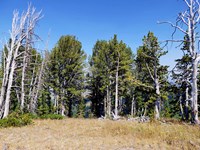Park managers could see that resources in parks were connected to neighbors and local communities. They initiated partnerships across regions, along rivers and trails, between cities and countryside. Others joined in the effort. Federal and state land management agencies took part in the conversation. Conservation groups and communities also got involved. They all recognized the importance of working at a landscape-scale. Partnering with others to conserve our shared heritage is more important than ever. The National Park Service is ready to work with your community to extend the benefits of natural and cultural resource conservation and outdoor recreation throughout this country and the world.
Here are some examples of how parks engage in connected conservation.
- Cuyahoga Valley National Park
Finding Moses Cleaveland Trees in Cuyahoga Valley
- Cuyahoga Valley National Park
Battling Invasive Plants in Cuyahoga Valley
- Cuyahoga Valley National Park
Creating Cuyahoga Valley National Park: 50 Moments That Tell the Story
- Locations: Cuyahoga Valley National Park

In honor of our 50th anniversary year in 2025, Cuyahoga Valley National Park is highlighting 50 key events that help define who and what we are. They showcase the many partners that have come together to preserve open space, create opportunities for recreation, clean up pollution, restore habitats, and save historic resources.
- Cuyahoga Valley National Park
When Was That? Key Dates in Making Cuyahoga Valley National Park
- Locations: Rocky Mountain National Park
- Offices: Inventory and Monitoring Division, Rocky Mountain Inventory & Monitoring Network
The Inventory and Monitoring Division explored the effects of the Cameron Peak and East Troublesome Fires on trout, their habitat, and their food sources in Rocky Mountain National Park. The results show that high-elevation trout are resilient, providing valuable insight for park managers making conservation decisions.
- Locations: San Antonio Missions National Historical Park
- Offices: Youth Programs, Youth Programs Division

Designed to prepare youth for careers in conservation and environmental planning, the Cultural Landscape Apprentice program matches young adults with opportunities to learn about cultural landscape management in a hands-on environment alongside National Park Service (NPS) employees at San Antonio Missions. Dijonta, DariAnn and Daniela’s 8-month long apprenticeship just ended at San Antonio Missions National Historical Park, and we asked them to share what they gained.
- Locations: Dinosaur National Monument
- Offices: Inventory and Monitoring Division, Northern Colorado Plateau Inventory & Monitoring Network
- Locations: Death Valley National Park
- Offices: Inventory and Monitoring Division, Mojave Desert Inventory & Monitoring Network
- Locations: Acadia National Park, Allegheny Portage Railroad National Historic Site, Antietam National Battlefield, Appalachian National Scenic Trail, Appomattox Court House National Historical Park, more »
- Offices: Eastern Rivers and Mountains Inventory & Monitoring Network, Greater Yellowstone Inventory & Monitoring Network, Inventory and Monitoring Division, Mid-Atlantic Inventory & Monitoring Network, National Capital Inventory & Monitoring Network, more »

From coast to coast, the NPS Inventory and Monitoring Division is helping park managers improve the health and function of forest ecosystems. From promoting resilient forests in the Northeast, to conserving whitebark pine in the West, to protecting Hawaiian forest birds from avian malaria, scientific partnerships are helping parks to share information, leverage funding sources, and work together for outcomes that extend beyond what any park could accomplish on its own.
- Locations: Crater Lake National Park, Devils Postpile National Monument, Glacier National Park, Grand Teton National Park, Lassen Volcanic National Park, more »
- Offices: Greater Yellowstone Inventory & Monitoring Network, Inventory and Monitoring Division
Last updated: September 17, 2020







